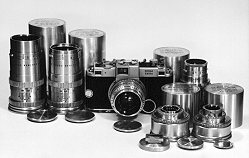"The Experts and the Eastman Kodak Ektra Camera"
Article © 2000 - 2007 K. Kekatos, reproduced with permission
 How long must camera collectors be burdened with the self-styled experts' pronouncements that the Eastman Kodak Ektra Camera was designed by imported left-handed German engineers? As this writer has repeatedly stated, the designer of the Kodak Ektra was a Hungarian, Joseph Mihalyi who emigrated to America in 1907 to join his older brother in St. Louis. After extensive employment with several optical instrument companies, he was hired by Eastman Kodak Company in 1923 as an apparatus designer, retiring in 1954 as Superintendent of Special Development Engineering.
How long must camera collectors be burdened with the self-styled experts' pronouncements that the Eastman Kodak Ektra Camera was designed by imported left-handed German engineers? As this writer has repeatedly stated, the designer of the Kodak Ektra was a Hungarian, Joseph Mihalyi who emigrated to America in 1907 to join his older brother in St. Louis. After extensive employment with several optical instrument companies, he was hired by Eastman Kodak Company in 1923 as an apparatus designer, retiring in 1954 as Superintendent of Special Development Engineering.
During his tenure at Kodak he designed and secured patents for the unique Kodak Pocket Rangefinder and the later Kodak Service Rangefinder, the Super Kodak Six-20, the Kodak Ektra and Medalist cameras and the Kodak Bantam Special with industrial designer Walter Dorwin Teague. He also proposed the automatic single exposure per film stop concept which was incorporated as modified by Chester Crumwine, in the 828 Bantam roll film configuration via spaced, single slots at the side of the film strip This method reappeared in the Kodak Instamatic 126 and 110 film cartridges, (also derived from Mihalyi's 1934 and 1944 patents
for a film holding package and camera) and is now universally employed in most single use camera film transport systems. Among his more than 200 patents, Mihalyi considered the Super Kodak Six-20 his most important design but he was very proud of the M-10 Rangefinder he developed during WW II for use in antiaircraft fire control systems and for which he was awarded a Presidential Citation by President Truman.
Mihalyi was not left-handed! He proposed that since one's right hand is stronger, it may be given the primary task of holding the camera, while through judicious design, (we call it ergonomic now) most or all camera controls be assigned to the left hand. What a masterful design the Kodak Ektra is! It served this writer in excellent fashion as the "family camera" for several years until that kindly old camera shop owner advised of its landmark status and it was moved to a collector's cabinet.
It is suggested that those experts have not lived with the Kodak Ektra and its functions thereby presenting a dilettante's view of reality. Furthermore they have not availed themselves of the Kodak literature associated with a "The World's Most Distinguished Camera" as Kodak publicity saw fit to proclaim.. Writers and researchers that eschew primary sources are prone to mouthing misinformation and espousing urban legends.
From one of the several Kodak Ektra announcements one may find the following:
"......A rhythmic operating cycle for all major adjustments, with controls at fingertips of one hand and all operating scales and dials visible from above...."
and in another brochure, the following;

"Picture taking with the Ektra follows a new, rhythmic operating cycle. The carefully designed main operating controls are so grouped as to be at the finger tips of one hand, the other hand being free for simply holding the camera firmly. The operating hand quickly adjusts the lens aperture by means of corrugated controls on the diaphragm sleeve. A turn of a prominently milled ring gives approximate focus, and the thumb completes the operation by activating the fine focusing knob. Instantaneous and retard shutter speed dials are located side by side on the operating side of the camera. The index finger fall naturally on the adjacent shutter release button. When the user wishes to include himself in the picture, one thrust with the thumb of the operating hand activates the delayed-action shutter mechanism."
"Film advancing and shutter winding are accomplished with similar efficiency. Two thumb strokes of the combination lever complete both operations, and in a situation demanding a quick series of exposures this action is simply alternated with the tripping of the shutter, without moving the camera from the eye."
"Besides optimum control of operative actions, the Ektra provides complete operative visibility - the instant ability to verify performance of operations and correctness of camera settings. All operating scales, dials, special index marks, and signals can be seen from above - those on the lenses as well as those atop the camera - and visible at the same time are the film-movement indicator and film type record on the camera back."
"The significance of the concentration of data can best be appreciated in connection with the operative action. Adjustment, operation, checking - all can be accomplished without changing one's grip on the camera, and without turning or twisting it at awkward angles. There is no lost motion - no lost time - no undue diversion from the subject at hand."
A design by a left-handed German engineer? Hardly!
|

